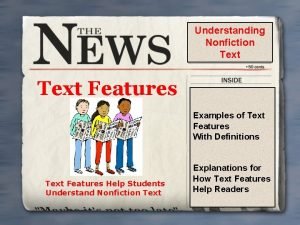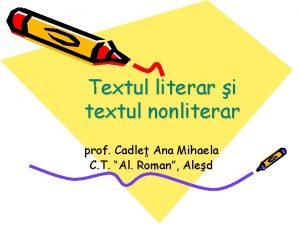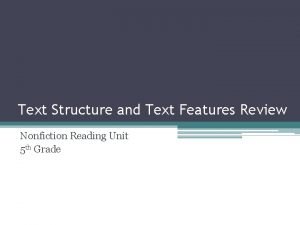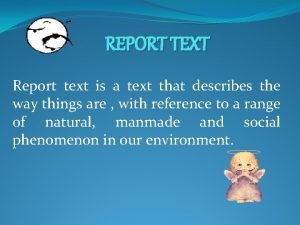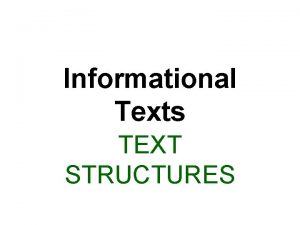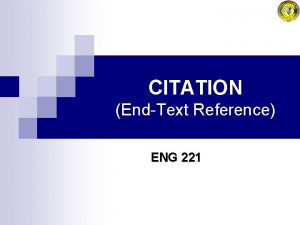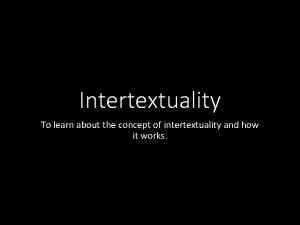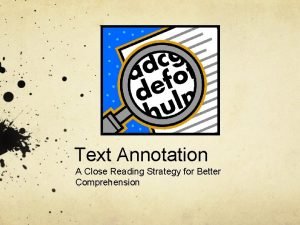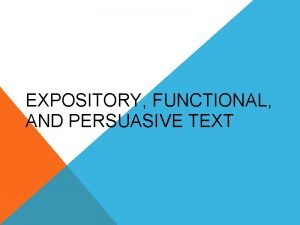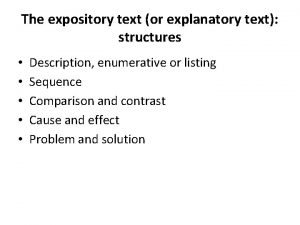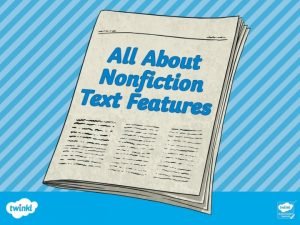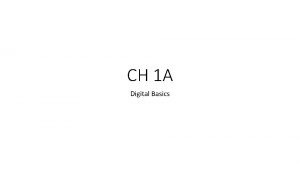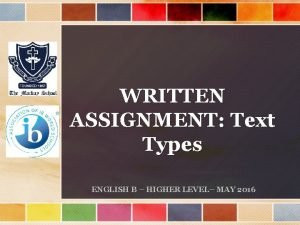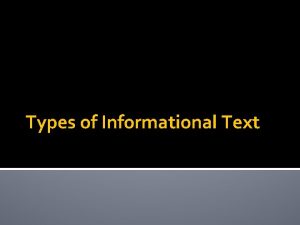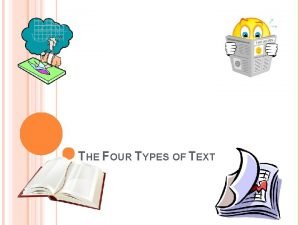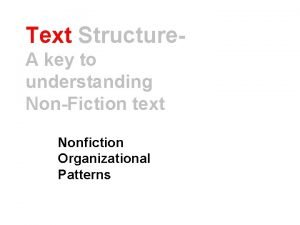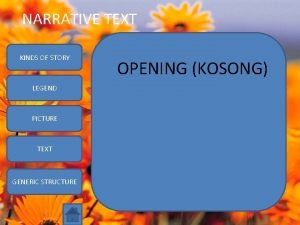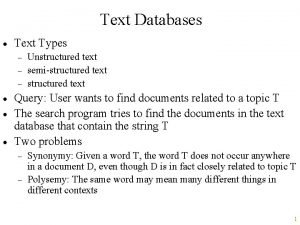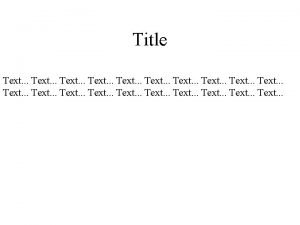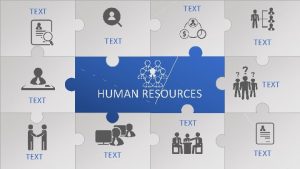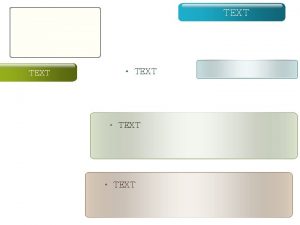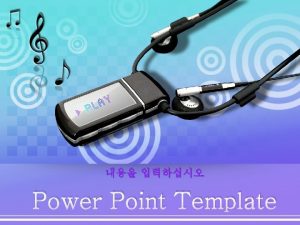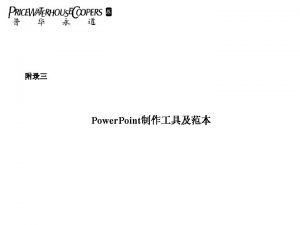TEXT TYPES 12 TYPES 1 2 3 4


























- Slides: 26

TEXT TYPES

12 TYPES 1. 2. 3. 4. 5. 6. 7. 8. Recount text 9. Spoof Text Narrative Text 10. Explanation Text Procedure Text 11. Discussion Text Description Text 12. Review Text News Item Text Report Text Analytical Exposition Text Hortatory Exposition Text

1. RECOUNT Social function : To retell events for the purposes of informing or entertaining Generic structure : Orientation : provides the setting and introduces participants ( giving information about what, who, where and when) event : to tell what happened in what sequence RE Orientation : optional , closure of events

Language features of RECOUNT Focus on spesific participant ( nouns and pronouns: we, David, the animal dll ) Material process ( Action verbs: go, sleep, run etc ) Past tense Temporal sequence ( after, before , then ) Conjuction ( but , and, …) Circumstances of time and place ( adverb / adverb phrases showing time and place ) * Adjectives to modify nouns

2. NARRATIVE SOCIAL FUNGTION To amuse, entertain, and to deal with actual or vicarious experience in different ways ( It deals with problematic events which lead to a crisis or turning point of some kind which in turn finds a resolution) Generic sructure: Orientation : sets the scene, introduces participant Evaluation : a stepping back to evaluate the plight Complication : a crisis arises Resolution : the crisis is resolved , for better or worse Re orientation : optional

Language features of narrrative Specific and individualized participant ( nouns or pronouns) Material process Behavioral process ( breathe, snore, dream…) Verbal process ( said, told, asked …) Mental process ( think, understand, like…. ) Relational process ( time connectives and temporal conjungtion ) Temporal circumstance Past tense

3. Procedure Social function : To describe how something is accomplished through a sequence of actions or steps Generic structure Goal Material (not required for all procedure teks) Steps 1 – n ( goal followed by a series of steps oriented to achieving the goal )

Language features of procedure Generalized human agents Simple present often imperative material process ( Action verbs ) Temporal conjunction or numbering to indicate sequence Adverbs to show the detail of time and place e. g for five minutes, two centimetes from the top…

4. Description Social function To describe a particular person, place or thing Generic structure Identification , identify phenomenon to be described Description : describe or giving information about specific participant eg : comes from…, the colour, the size, the favourite things etc

Language features of description Specific participant ( nouns ) Simple present Attributive and identifying Process ( relating verbs which informs about the subject) Various adjectives like : describing, numbering, classifying , two white fangs, two strong legs etc Detailed noun phrase to inform about the subject

5. News items Social function: To inform readers , listeners or viewers about events of the day which are consedered newsworthy or important Generic stucture : Newsworthy event(s) : recount the events in summary form Background events : elaborate what happenend to whom, in what circumstancec Sources : comment by participants in, witnesses to and aythorities expert on the events

Language features of news item Short telegraphic information about story captured in headline Focus on person, animal, certain thing Focus on circumstance Material process ( action verbs ) Verbal process in sources stages Past tense Arranged in sequence of events

6. REPORT Social function : to describe the way things are with reference to arange of natural , man made and social phenomena in our environment it is the result of systematic observation or analysis it is general conclusion, general statement about Generic structure: Generic classification: tell what phenomena under discussion is Description : tells the phenomena is like in the terms of *parts and their function *Qualities *Habits or behaviours

Language features of report General nouns : reptiles in Comodo island Relating verbs / relational process ( is , are, …) Action verbs ( birds fly, they eat…) Present tense Technical terms ( water contain hydrogen and oxygen. . ) Paragraph with topic sentence to arrange some information

7. ANALYTICAL EXPOSITION Social function : To persuade the reader or listener that something is the case that there is a case to concern, to pay attention to ) Generic stucture: Thesis Position : introduces topic and indicates writers position Preview : outlines the main arguments to be presented Arguments Points : restates main arguments outlined in preview Elaboration : develops and supports each point / argument

Language features of analytical exposition General nouns : cars , pollution, handphone Abstract nouns : pilocy, government… Technical terms : species of animal… Relating verbs Action verbs Thingking verbs Modal verbs Connectivers Evaluative words : important, valuable…

8 HORTATORY EXPOSITION Social function: To persuade the reader that something should or should not be the case It exhort someone to take or to desist in some action Generic structure: Thesis : announcement of issue of concern Arguments : reasons for concern, leading to recommendation Recommendation : statement of what ought not to happen

Language features of hortatory exposition Generic human and non human participant Mental process : to state what the writers thinks or feels about the issue Material process to state what happens Relational process to state what it should be Simple present Abstract nouns Technical verbs Passive form Modal verbs Evaluative words

9. SPOOF Social function : To retell an event with humorous twist Generic structure: Orientation : sets the scene Events Twist : tell what happened : provides the punchline

Language features of spoof Focus on person, animal, certain thing Action verb Past tense Circumstance of time and place Material process

10. Explanation Social function: To give an account of how something works or reasons for some phenomenon ( why is it so? How does it work? ) Two basic types : Explaining how : mechanical explanation ( how does a pump work? ) Technological explanation ( how does a computer work? ) System explanation ( How does a company work? ) Natural explanation ( how are mountains formed? ) Explaining why : Why does things float and other sink? Why does iron go rusty? Generic structure : General statement A sequenced explanation of why or how something occurs

Language features of explanation General and abstract noun Action verbs Simple present tense Passive form conjunction of time cause and effect relationships Noun phrase Abstract nouns Adverbial phrases Complex sentences Technical terms

11. Discussion Social function To present ( at least ) two points of view about an issue To look at an issue from a range of perspectives before making judgement or recommendation Generic structure : Issue : statement and preview Argument for and against or statements of differnet point of view : point and elaboration Conclusion or recommendations

Language features of discussion Generic human and non human participants Material processes Relational processes Mental processes : feel , believe, think … Comparative : contrastive Consequential conjunction Reasoning expresses as verbs and nouns

12. Review Social function : To critique an art work or event for a public audience ( works of art include movies, TV shows, books, plays, operas, recordings, exhibition, concert and ballets ) Generic structure : Orientation : places the work in its general and particular context. Often by comparing it with its kind or through analogue with a non art object or events Interpretative Recount : summaries the plot and / or provides an account of how the work came into being Evaluation : usually recursive ( evaluation 1, 2, 3, … ) Evaluative summation

Language features of review Focus on particular participant Attitudinal lexis to show Direct expression of opinion, including attitudinal epithets in nominal groups Qualitative attributive and affective mental processes Elaborating and extending clauses Metaphorical language
 Making connections
Making connections Types of text linear text
Types of text linear text Nonfiction text features examples
Nonfiction text features examples 2 texte nonliterare
2 texte nonliterare What text features are included in this text
What text features are included in this text Report text bees
Report text bees Text to self examples
Text to self examples Text _____ in a nonfiction text is its organization.
Text _____ in a nonfiction text is its organization. End-text reference
End-text reference Intertextuality
Intertextuality Annotation symbols for close reading
Annotation symbols for close reading Language translation
Language translation Narrative vs expository
Narrative vs expository Linear text to nonlinear text
Linear text to nonlinear text Text analytics and text mining
Text analytics and text mining Expository texts
Expository texts Text analytics and text mining
Text analytics and text mining Expository text structures
Expository text structures What text features are included in this text
What text features are included in this text Plain, unformatted text is sometimes called ascii text.
Plain, unformatted text is sometimes called ascii text. Text types english b
Text types english b Types of informational text
Types of informational text Text types examples
Text types examples Dse writing word limit
Dse writing word limit Examples of narrative texts
Examples of narrative texts Types of nonfiction text structure
Types of nonfiction text structure Narrative legend
Narrative legend


